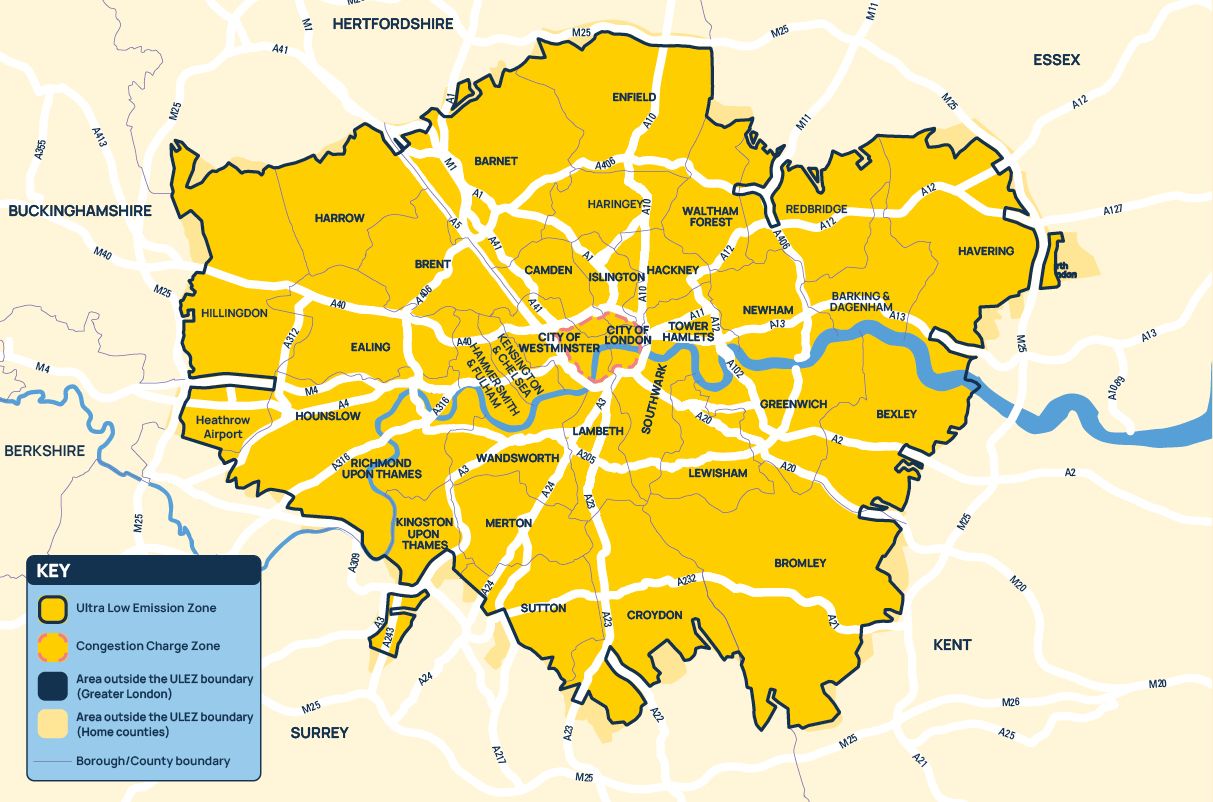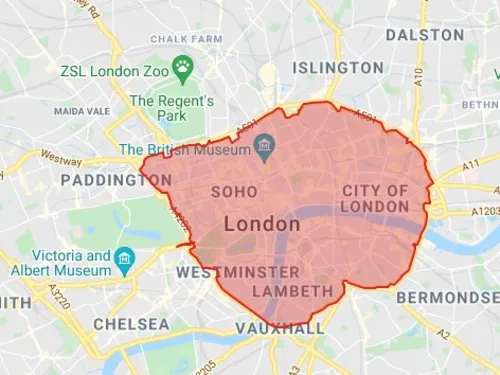ULEZ stands for Ultra Low Emission Zone, and this is something that has been implemented to improve air quality in certain areas in the UK. To be able to drive in this zone, there are ULEZ emission standards that vehicles will need to meet, including vans and cars. If these standards are not met, charges must be paid.
What areas are affected by ULEZ?
The Ultra Low Emission Zone (ULEZ) operates 24 hours a day, 7 days a week, every day of the year (except Christmas Day) and affects all London boroughs and the City of London, not including the M25.
Check the map on the right to see what areas car operating ULEZ.

What are the ULEZ Charges?
If your vehicles do not meet the ULEZ emission standards, you will need to pay a daily charge in order to drive in the Ultra Low Emission Zone.
The charges are as follows:
- £12.50 per day for most vehicle types, including motorcycles, cars, vans and specialist vehicles (up to and including 3.5 tonnes) and minibuses (up to and including 5 tonnes).
- Heavier vehicles, such as lorries, vans or specialist heavy vehicles (all over 3.5 tonnes) and buses, minibuses and coaches (all over 5 tonnes) do not need to pay the ULEZ charge, they’ll need to pay the LEX charge instead.
As you can see, the costs can quickly mount if you are driving through this area regularly and your vehicle does not meet the requirements that are in place.
If you do not pay the charge, a Penalty Charge Notice (PCN) will be issued to you. His penalty is in addition to any Low Emission Zone penalties or Congestion Charges you receive.
It is possible to set up auto-pay, which is highly recommended if your vehicle does not comply and you will pass through the area regularly. This will ensure you do not miss any payments and do not get fined.
Which vehicles are exempt?
The current standards require vehicles to meet Euro 4 standards for petrol and Euro 6 for diesel. With the new rules, all petrol and diesel vehicles must meet Euro 6 standards or pay the daily charge.
A fully-electric cars are of course exempt due to its zero emissions. Hybrid cars and mild hybrids must meet Euro 4 or 6 depending on their fuel type.
ULEZ also applies to motorbikes, lorries, buses and coaches. Motorbikes must meet Euro 3 standards, lorries and buses must meet Euro VI standards and coaches must meet Euro V standards or pay the daily charge.
What is a Clean Air Zone (CAZ)?
Clean Air Zones are designated areas where local authorities aim to improve air quality by reducing harmful emissions. Some cities in the UK have already implemented these zones, with London being the largest. Vehicles that do not meet emission standards are charged a fee for entering these zones, while electric or hybrid cars are exempt from these charges. The objective of these zones is to lower pollution levels, particularly in areas that are heavily trafficked. As the health impacts of air pollution continue to receive attention, more local authorities are likely to implement Clean Air Zones in the future.
The introduction of Clean Air Zones supports the UK's goal of reaching net-zero carbon emissions by 2050, highlighting the importance of sustainable transportation solutions.
What are the types of clean air zones?
There are four classes of Clean Air Zones: A, B, C and D. They exempt certain vehicles, but the emissions standards are broadly in line with the London Ultra Low Emission Zone (ULEZ).
- A - Buses, coaches, taxis, private hire vehicles
- B - Buses, coaches, taxis, private hire vehicles, heavy goods vehicles
- C - Buses, coaches, taxis, private hire vehicles, heavy goods vehicles, vans, minibuses
- D - Buses, coaches, taxis, private hire vehicles, heavy goods vehicles, vans, minibuses, cars, the local authority has the option to include motorcycles
Where are the clean air zones in the UK?
- Bath has a Class C clean air zone.
- Birmingham has a Class D clean air zone.
- Bradford has a Class C clean air zone.
- Bristol has a Class D clean air zone.
- Portsmouth has a Class B clean air zone.
- Sheffield has a Class C clean air zone.
- Tyneside (Newcastle and Gateshead) has a Class C clean air zone.
There are different rules if you want to drive in a low emission zone in Scotland.
Low emission Zones (LEZ) were introduced across Aberdeen, Dundee, Edinburgh and Glasgow on 31 May 2022.
Currently they are all in a grace period until it will be enforced on the following dates:
- In Glasgow, the LEZ has applied to buses since 2018. For other vehicle types, enforcement began on 1 June 2023 (enforcement begins on 1 June 2024 for residents within the zone)
- Dundee will start enforcement on 30 May 2024
- Aberdeen will start enforcement on 1 June 2024
- Edinburgh will start enforcement on 1 June 2024.

How much will I be charged in a clean air zone ?
Location | What Emission Scheme is it part of? | Daily charge | When are the zones active? |
Aberdeen | Scottish LEZ (similar to CAZ Class D) | Penalty of £60 (reduced to £30 if paid within 30 days) | 24/7 |
Bath | Class C CAZ (vans +) | £9 for small vehicles; £100 for large | 24/7 |
Birmingham | Class D (cars +) | £8 for small vehicles; £50 for large | 24/7 |
Bristol | Class D (cars +) | £9 for small vehicles; £100 for large | 24/7 |
Bradford | Class C (vans +) | £7 for taxis; £9 for small vehicles; £50 for large | 24/7 |
Dundee | Scottish LEZ (similar to CAZ Class D) | Penalty of £60 | 24/7 |
Edinburgh | Scottish LEZ (similar to CAZ Class D) | Penalty of £60 | 24/7 |
Glasgow | Scottish LEZ (similar to CAZ Class D) | Penalty of £60 | 24/7 |
London (ULEZ) | Class D (motorcycles/mopeds +) | £12.50 for small vehicles. Large vehicles pay a LEZ charge instead. | Every day except Christmas |
Oxford (ZEZ) | Class D (motorcycles/mopeds +) | £2 for ultra low emission vehicles; £4 for low emission vehicles; and £10 for non-compliant vehicles | 7am-7pm daily |
Newcastle & Gateshead | Class C (vans +) | £12.50 for small vehicles; £50 for large | 24/7 |
Portsmouth | Class B | £10 for taxis; £50 for large vehicles | 24/7 |
Sheffield | Class C (vans +) | £10 for small vehicles; £50 for large | 24/7 |
Southampton | Class B | Non-charging | 24/7 |
York | Class A | Non-charging | 24/7 |
Correct at time of publishing: 05/24
When will my city introduce Clean Air zones?
Here's a list of cities and their CAZ intiative plans
- Basildon: Restrictions along the A127 Arterial Road are being considered.
- Caerphilly: A Heavy Goods Vehicle Ban is under strong consideration on the A472 within Hafodrynys Hill.
- Cambridge: A review is underway for a Clean Air Zone within the Air Quality Management Area, potentially including the city center and inner ring road.
- Canterbury: The council is planning alternative measures to combat emissions, such as anti-idling of vehicles and incentives for bus companies and taxis to switch to less polluting vehicles. No plans for Clean Air Zones have been announced.
- Cardiff: The city is in favor of a £2 a day congestion fee for non-residents.
- Coventry: Instead of a Clean Air Zone, Coventry's Road Improvement scheme and cycle lanes have been accepted by the UK Government.
- Derby: Derby is strongly against a Clean Air Zone and has proposed improvements and cycle schemes, including cycle lanes.
- Exeter: The council of Exeter opposes the Clean Air Zone and promotes the use of public transport over vehicle restrictions.
- Leeds: Leeds no longer requires a Clean Air Zone due to a significant shift towards low emission vehicles. Research shows that over 80% of buses and heavy goods vehicles meet the Euro 6 standards, making them exempt.
- Leicester: Similar to Leeds, Leicester no longer requires a Clean Air Zone scheme.
- Liverpool: Details are yet to be released, but discussions have involved a city-wide ban and an anti-idling scheme.
- Manchester: The council is reviewing the Clean Air Zone, which is expected to operate 24/7. Private cars will be exempt from charges.
- Nottingham: Plans are in place to reduce pollutants from the council fleet vehicles, taxis, and buses, therefore a CAZ isn’t being considered at this time.
- Southampton: A non-charging Clean Air Zone has been in effect since 2017. There are currently no plans to make it chargeable, thanks to implemented measures targeting pollutants.
- Nottingham: This city doesn’t require any Clean Air Zone Initiative. Nottingham have plans in place to reduce pollutants form the Council Fleet vehicles along with Taxis and Busses.
- Southampton: A Clean Air Zone has been running since 2017 however this is a non charging zone. Currently there are no plans to make the Clean Air Zone Chargeable following an implementation of measures that target vehicles such as Taxis buses and Heavy Goods Vehicles.
- Sefton: Plans are undecided after conducting a report on the city.
- St. Albans: The city is expected to move towards anti-idling restrictions rather than a CAZ charge.
- Warrington: A five year pollutant reduction plan has been put in place however a CAZ is still under consideration for the city.
- Wokingham: Wokingham Council have a Low emission Zone under consideration.
Contact us today for more information
If you want to know more about the ULEZ charges, or you want to find a vehicle that adheres to the ULEZ emission standards so that you are not subject to daily charges, please do not hesitate to get in touch with our friendly team at Swansway Motor Group today for more information.
Our professional and experienced team is always happy to help you in any way they can! You can use our online chat service to get help right away. Alternatively, you can head to our contact page and find the telephone details for our individual garages. We can help you to select the most economical vehicle for your budget.
